Don't wanna be here? Send us removal request.
Text
Week 31: King Cobra Snake

This is the Ophiophagus hannah, more commonly known as the king cobra. It belongs to the Animalia kingdom, Chordata phylum, Reptilia class, Squamata order, Elapidae family, and Ophiophagus genus. It is a species of venomous snake which is from Asia, also found in India.
King cobras are carnivores and can live up to 20 years in the wild. They can get up to 18 feet long, its common characteristic being that it can “stand up” in aggression. They also have some of the most fatal venom in the world among snakes.
King cobras are also the only species of snake that build nests to lay eggs in, which they guard very attentively. They sense ground vibrations and often do not like to go near humans, but will if they feel like they or their eggs are being threatened.

Info sources: x x
Image sources: x x
1 note
·
View note
Text
Week 30: Red-Bellied Black Snake

This is the Pseudechis porphyriacus, more commonly known as the red-bellied black snake. They are in the Animalia kingdom, the Chordata phylum, the Reptilia class, the Squamata order, the Elapidae family, and the Pseudechis genus. They are native to eastern Australia, and is a species of Elapid snake; Elapid meaning a type of snake that has fangs at the front of its mouth. They are common in forests, but have also been found in urban areas of Australia.
The red-bellied black snake is a venomous snake. However, they have not usually been known to be fatal bites. They are known for their beautiful appearance and can grow to up to two meters long. They eat frogs and other reptiles and smaller mammals and are seen around cool, wet areas. Red-bellied black snakes can also eat other snakes.

Red-bellied black snakes are pretty much described with their name. They are covered in black scales with a brown snout, and a cream and red colored underside. They are active by day, and as I mentioned before, this species is dangerously venomous. Their breeding occurs through spring and summer, and the babies are around 22 cm.

Info sources: x x x
Image sources: x x x
0 notes
Text
Week 29: Crown of Thorns Starfish
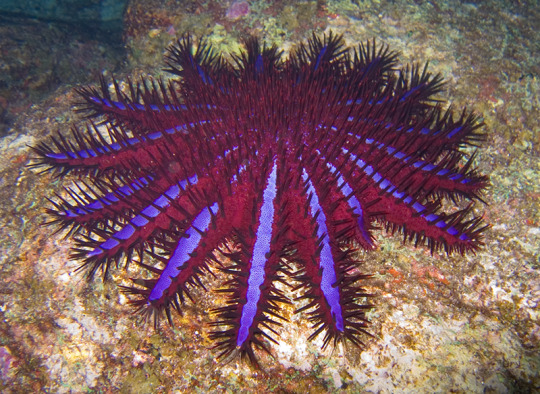
This is the Acanthaster planci, more commonly known as the crown-of-thorns starfish. They are a part of the Animalia kingdom, the Echinodermata phylum, the Asteroidea class, the Valvatida order, the Acanthasteridae family, and the Acanthaster genus. The crown of thorns starfish are known for their vibrant colors and unique exterior.
The crown of thorns starfish resides in the Indo-Pacific area on coral reefs. They feed on corals that help the environment of the Great Reef. They usually spwan during the warmer months, producing very large amounts of eggs. They are more likely to be attacked in their older years.

The crown of thorns starfish come in a variety of colors, as you can see from the pictures included. The long spines that you see are venomous and they can grow up to 80 cm. For this reason, they do not have many predators, although they are still threatened by environmental factors and some predators.
Crown of thorn starfish can appear in very high densities throughout coral reefs that are called outbreaks. They help in species diversity within reefs.

Info sources: x x x
Image sources: x x x
21 notes
·
View notes
Text
Week 28: Honduran Milk Snake

This is the Lampropeltis triangulum hondurensis, more commonly known as the Honduran milk snake. This is actually a sub-species, which is why its scientific name has three parts. It is a part of the Animalia kingdom, the Chordata phylum, the Reptilia class, the Squamata order, the Colubridae family, the Lampropeltis genus, and the L. triangulum species. As you probably already guessed, this species originated in Honduras.
The Honduran milk snake is red with black or yellow stripes. Adults can get up to about 48 inches long and can live to up to 20 years in the wild. Although they are named after their origin country, they reside mostly in Nicaragua, Costa Rica, and Honduras. They are considered sexually mature at 18 months old.

These snakes usually eat lizards, some rodents, and even other snakes when they need to. Despite these habits, Honduran milk snakes are actually not venomous. They are colored to resemble some venomous snakes, however, which threatens other creatures. They are nocturnal, and are powerful constrictors.
http://www.livescience.com/53333-milk-snakes.html
Info sources: x x x
Image sources: x x
1 note
·
View note
Text
Week 27: Giant Oarfish

This is the Regalecus glesne, more commonly known as the giant oarfish. This species is a part of the Animalia kingdom, the Chordata phylum, the Actinopterygii class, the Lampriformes order, the Regalecidae family, and the Regalecus genus. It can also be known as the ribbon fish or streamer fish. It is the world’s longest fish.
The giant oarfish is fairly rare and is known as the longest bony fish in the world. It has a long, thin shape which is where it gets its name from. They can grow up to 50 feet long and weigh 600 pounds. They do not have scales.

Despite its frightening appearance, the giant oarfish only feeds on small crustaceans and fish, with small, nonvisible teeth. There is not much known about this species because the most common viewing is when they are washed up on shore after storms. They stay mostly near the surface of the water in warmer parts of the coast of Mexico and the Bahamas. They do not stay in packs as adults; they live mostly in solidarity.
Image sources: x x
Info sources: x x
0 notes
Text
Week 26: Sand Tiger Shark

This is the Carcharias taurus, better known as the sand tiger shark (not the same species as the tiger shark). It is also called the grey nurse shark or the blue nurse sand tiger. It is part of the Animalia kingdom, the Chordata phylum, the Chondrichthyes class, the Lamniformes order, the Odontaspididae family, and the Carcharias genus.
Its name might make you think it’s related to the tiger shark; however, it is more closely related to the great white shark. They have a scary appearance and a very strong swimming ability. Despite this, sand tiger sharks have no confirmed cases of attacking a human. They are known for a relatively gentle nature.

Sand tiger sharks can get up to 11 feet tall, 350 pounds, and can live for up to 17 years. They can be found mostly in warm, coastal waters and are very social creatures; they remain social all year long. These sharks usually stay in groups which is uncommon for many sharks.
The females have two uteruses and give birth to one or two pups a year. Unfortunately, sometimes these sharks can feed on juvenile sand tiger sharks, so most young find safer places to inhabit until they have grown up.
Sand tiger sharks have a very interesting way of staying afloat; they hold air in their stomach which allows them to hover without moving. This comes in handy when they are hunting prey, which includes small fish, smaller sharks, sting rays, and squid.

Info sources: x x
Image sources: x x x
5 notes
·
View notes
Text
Week 25: Humpback Whale

This is the Megaptera novaeangliae, more commonly known as the humpback whale. It is part of the Animalia kingdom, the Chordata phylum, the Mammalia class, the Artiodactyla order, the Balaenopteridae family, and the Megaptera genus.
Humpback whales are known for their large size, tourist attraction, and their songs; low-pitched “singing” that is thought to attract mates, and can be heard from 20 miles away.
Again, these whales are known for their size, which can get up to about 40 tons and up to 60 feet long; comparable to a bus. Females grow larger than males. They are known for their long fins which can get up to 15 feet long. They are usually dark grey/blue and white on their undersides.

Humpback whales are able to breach, meaning they can jump out of the water, as well as slapping their fins on the surface. This makes them a popular whale watching species and attracts many people to come see their jumping displays.
They mostly eat tiny crustaceans like krill, plankton, the occasional small fish, and algae. They are omnivorous and can eat up to 3,000 pounds a day. During the winter, humpback whales tend to travel to tropical waters, and during the rest of the year, they stay in high altitude oceans.

Image sources: x x x
Info sources: x x
1 note
·
View note
Text
Week 24: Hourglass Dolphin

This is the Lagenorhynchus cruciger, more commonly known as the hourglass dolphin. It is in the Animalia kingdom, the Chordata phylum, the Mammalia class, the Artiodactyla order, the Delphinidae family, and the Lagenorhynchus genus.
This species is very rarely seen and very little is known about it. However, it is known for its resemblance similar to the killer whale with its distinct black and white patterns. Their fins are generally curved and the patterns of color are curved, as well.
The hourglass dolphin is usually found in cold Antarctic waters, although there have been some sightings around South America. Even though there haven’t been very many observances of this species, they have been noted eating small fish and even feeding on seagulls that dip down low enough to the surface.

Like most other dolphins, the hourglass dolphin is a generally social species. They are found in pods of 5-8, and even pods of 60 have been seen. Males can get up to 1.6 meters while females can get up to 1.8 meters long. Males are slightly shorter than females.
Image sources: x x Info sources: x x
0 notes
Text
Week 23: Chinese White Dolphin

This is the Sousa chinensis, more commonly known as the Chinese white dolphin. This species often gets confused with the Baiji, or the Chinese river dolphin; however, they are two different species. The Chinese white dolphin is in the Animalia kingdom, the Chordata phylum, the Mammalia class, the Artiodactyla order, the Delphinidae family, and the Sousa genus.
Interestingly enough, these dolphins are born black and as they grow, their skin begins to lighten. Adults are pink or white, which makes them unique from other dolphins. They are often found with a mix of pink and gray.
The Chinese white dolphin has a round body, which makes them fast swimmers. They also have thicker layers of blubber than most dolphins, and this is because of where they live; along coasts of warmer waters around China.

Chinese white dolphin mothers are known for taking good care of their young. Their young will stay with the mother until 3 years old, and can live up to 40 years. Unfortunately, they are hunted often by humans and are very susceptible to disease, which makes it hard for them to live in polluted water. For this reason, they don’t usually live as long as they could and are considered an endangered species.
As I mentioned before, Chinese white dolphins are very good at swimming which makes them good predators. Unlike other dolphins, however, this species is very picky, and usually only eat medium sized fish unless they really need food and their ideal meal isn’t available.

Image sources: x x x
Info sources: x x
0 notes
Text
Week 22: Mimic Octopus

This the Thaumoctopus mimicus, more commonly known as the Mimic octopus. It is in the Animalia kingdom, the Mollusca phylum, the Cephalopoda class, the Octopoda order, the Octopodidae family, and the Thaumoctopus genus.
As you can tell by the name of this organism, the mimic octopus is known for its ability to camouflage and change their skin color and skin texture. Not only can they blend into their environment, but they can blend into other living things in their environment; they are able to take shape of many other marine animals. They do this to avoid predators.
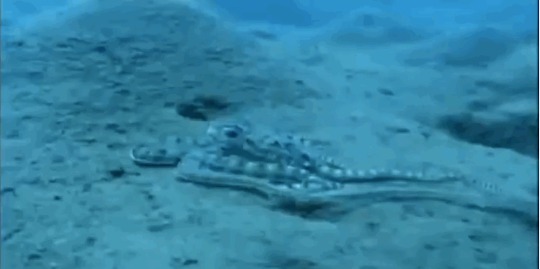
The mimic octopus is known to prefer muddier and warmer waters, and are found mostly across the coasts of South East Asia. Their diet consists of crabs and small fish, and they also take part in cannibalism because of their territorial nature.
After mating, the male mimic octopus will die soon after. The female will lay the sack of eggs, and soon after the eggs become ready to hatch, the female dies, meaning that the baby mimic octopi have to fend for themselves. As they grow, they can reach up to two feet long fully grown.

Info sources: x x
Image sources: x x x
3 notes
·
View notes
Text
Week 21: Blue Shark

This is the Prionace glauca, also known as the blue shark. They are a part of the Animalia kingdom, Chordata phylum, Chondrichthyes class, Carcharhiniformes order, Carcharhinidae family, and the Prionace genus.
Blue sharks are long and thin, and are usually lethargic although they can move quickly if needed. They prefer cooler waters and are able to migrate very long distances. They have been found in Norway and in South America; almost every coast of every continent but Antarctica.
Blue sharks are viviparous and give birth to live young after 12 months. The average number of pups that are birthed per litter are 50. They can grow up to 3 and a half meters.

As you can see, these sharks have a blue/greenish tint which is where their name comes from. Like I mentioned before, these sharks are capable of swimming fast when they are in danger, excited, or feeding, even though they are generally lethargic creatures. They have aerodynamic bodies that are designed to be able to catch their pray that include octopus, squid, lobsters, crabs, many fish, and even other species of small sharks.
They have long fins that help with swimming and teeth that help latch on to slippery pray. Unfortunately, these sharks are near threatened. Since they are so distributed throughout the world, they are found as an easy target sports.

Info sources: x x x
Image sources: x x x
2 notes
·
View notes
Text
Week 20: Port Jackson Shark

This is the Heterodontus portusjacksoni, more commonly known as the Port Jackson shark. They are a part of the Animalia kingdom, the Chordata phylum, the Chondrichthyes class, the Heterodontiformes order, the Heterodontidae family and the Heterodontus genus.
This shark is a known to be more migratory than most sharks. They travel south during the summer and back north during the winter, which is when they breed. Port Jackson sharks are oviparous sharks, meaning they lay eggs.
There are many features which distinct these sharks from others, including their pattern. They have black markings across their eyes which cross over onto the body, making them easy to identify. They have blunt heads, sharing some classifications with the hammerhead shark.

Another feature that distinguishes these sharks are their teeth. Unlike what you think of when you think of “shark”, Port Jackson sharks have smaller, pointed teeth and generally smaller mouths. With these teeth, they are able to crack and crush molluscs and other hard-shelled organisms including sea urchins, and sometimes small fish.
They are actually able to breathe and eat at the same time; they suck in water and blow out the sand through gills, and then retain the food, making breathing possible.
Port Jackson sharks can get up to 1.65 meters, although the general females are larger and can get up to 95 centimeters long, while males can get up to 80 centimeters long.

Info sources: x x
Image sources: x x x
0 notes
Text
Week 19: Zebra Shark

This is the Stegostoma fasciatum, commonly known as a zebra shark. They are part of the Animalia kingdom, Chordata phylum, Chondrichthyes class, Orectolobiformes order, the Stegostomatidae family, and the Stegostoma genus.
Zebra sharks are a species of carpet sharks that are found throughout the Pacific, mostly in coral reefs and sandy areas. They are nocturnal and stay still during the day, while at night they hunt for small fish and sometimes sea snakes. Adults have a spotted pattern and tan skin which helps them blend into the seafloor to stay away from predators.

As you can see in the picture above, when zebra sharks become adults, their stripes turn into dark spots. They can get up to about 12 feet long, but the average length is 7.5 feet. Humans are the biggest threat to zebra sharks; they have very little predators. They reproduce by producing eggs which latch onto rocks and hatch.
Image sources: x x
Info sources: x x
0 notes
Text
Week 18: Basking Shark

This is the Cetorhinus maximus, more commonly known as the Basking Shark. It is part of the Animalia kingdom, the Chordata phylum, the Chondrichthyes class, the Lamniformes order, the Cetorhinidae family, and the Cetorhinus genus.
Despite its name, the Basking Shark is actually a fish; the second largest fish in the world after the whale shark. As you can see, its mouth is wide open most of the time, and this is so it can catch plankton; don’t be fooled by its giant mouth, it has no interest in humans.
The basking shark is found in warm oceans and stays near the surface of the water. They can be found all over the world in warm waters. They are usually gray or brown and have very developed gill rakers. They have a generally passive lifestyle and can be found alone or in small schools.
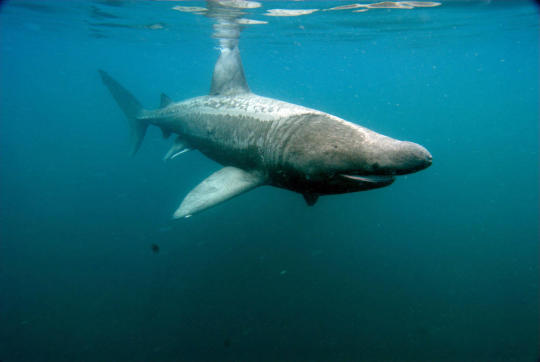
Basking sharks are known for their size and can grow up to 9 meters long and weigh an average of 3,700 kilograms. Their mouths can get up to 1.2 meters wide which makes filter feeding easier. They also have several small teeth.
They give birth to live young, but their place of birth is unknown, although some think that they surface to give birth.
Info sources: x x
Image sources: x x
52 notes
·
View notes
Text
Week 17: Bull Shark

This is the bull shark, its scientific name being Carcharhinus leucas. It is in the Animalia kingdom, the Chordata phylum, the Chondrichthyes class, the Carcharhiniformes order, the Carcharhinidae family, the Carcharhinus genus.
The bull shark is known for its aggression and fearlessness. They can survive in both freshwater and saltwater environments, and stay in warm shallow water. They are found worldwide.

As you can see from this picture, bull sharks get their name from their blunt snouts and larger bodies. They are considered one of the most dangerous sharks to humans because they are very likely to attack out of curiosity and aggression.
They can get up to 11 feet long and up to 500 pounds. On average, they live to about 16 years old. Bull sharks gray on top and white underneath. They are carnivores and will generally eat any living thing that happens to come their way, including humans.
Info sources: x x
Image sources: x x
0 notes
Text
Week 16: Black-banded Sea Krait
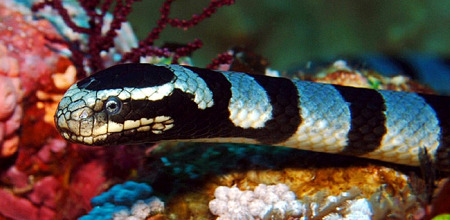
This is the black-banded sea snake. Its scientific name is the Laticauda colubrina, belonging to the Animalia kingdom, the Chordata phylum, the Reptilia class, the Squamata order, the Elapidae family, and the Laticauda genus.
These sea snakes can actually live on land and water, and are known for having some of the most venomous poisons in the world. However, they are extremely docile so humans rarely get bitten. They live mostly in coastal waters and are mostly found in coral reefs. They live off the coasts of the Pacific islands, the Philippines, southeast Asia, and Japan.
The black banded sea krait is shaped cylindrically, but their tale is paddle shaped to help with swimming. They often have a gray, white, or blue body and black stripes.

Unlike other sea snakes, the black banded sea krait lay their eggs on land, which is where mating occurs. They feed on eels and sometimes small fish. Adult males can grow up to 30 inches, while the females grow much larger than that; about 50 at the peak of growth. Because of this, females can hunt in deeper waters because their bodies can withstand the water pressure.
The left lung of this sea snake actually runs all the way through their bodies, which makes them able to hold their breath for a long period of time. Eventually, they have to come up to breathe.

Info sources: x x x
Image sources: x x x
0 notes
Text
Week 15: Blue-ringed Octopus

This is the Hapolachlaena lunalata, better known as the blue-ringed octopus. They are a part of the Animalia kingdom, the Mollusca phylum, the Cephalopoda class, the Octopoda order, the Octopodidae family, and the Hapalochlaena genus.
Blue-ringed octopi live in tide pools and coral reefs around the Indian ocean and Pacific ocean. They are known for being the most venomous marine animals, their venom being powerful enough to kill humans. Despite this, however, this species is relatively docile.
They are known for their yellowish brown skin and bright blue rings that appear to become even more vibrant when the octopi becomes stressed or agitated. They weigh 28 grams and are 5 centimeters long with longer arms.

The blue-ringed octopus feeds mostly off of small crustaceans such as small crabs and shrimp. After they mate, the females lay 50 eggs and those eggs are incubated by the mother for 6 months until they hatch.
It is important to be extremely careful not to come near one, as mentioned before, because they are extremely venomous and can be fatal if the bite goes untreated.
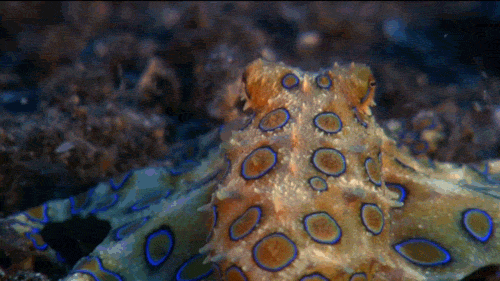
Info sources: x x
Image sources: x x x
0 notes